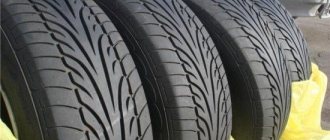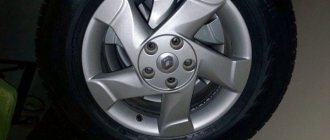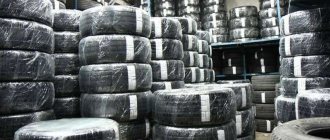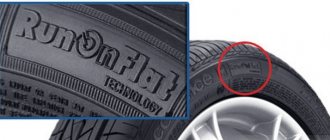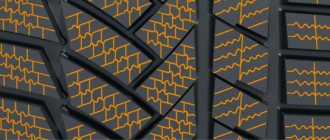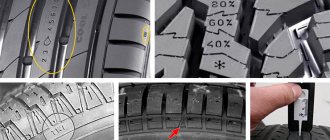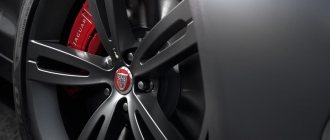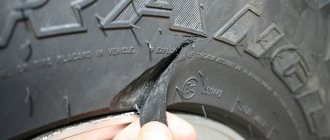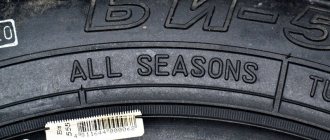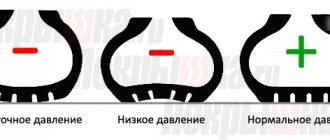Tires for any season. Is it possible?
All-season tires combine the characteristics of summer and winter tires. It saves the driver from seasonal changes, but it is a mistake to think that it can be used instead of full-fledged winter and summer tires.
These tires are designed for countries with mild climates, where the air temperature in winter does not drop below – 7 °C, and the summer heat is kept within reasonable limits (no more than +25 °C).
Winter tires have a high tread that protects from snow and deep grooves to drain water. Summer tires provide good grip due to a large contact patch with the surface.
Winter tires are softer and do not “tan” in severe frost, while summer tires are stiffer and do not melt under high temperatures.
The combination of these completely opposite qualities in one product is impossible, so all-season tires can only be used in temperatures ranging from -5...-7 °C to +25...+27 °C.
All-season and all-season tires in tests
In this article we will use data from one of the most authoritative experts in the industry - the German automobile club ADAC. The entire automotive environment is waiting for the seasonal tests of this organization, and many drivers, based on their results, make the final decision on choosing a specific model. The German organization checks all-season, summer and winter tires annually. We compared the results of individual tests to get an idea of how different types of tires perform in certain conditions. For clarity of results, we used the three most recent tests for each tire type:
- ADAC 2021 all-season tire test for size 175/65 R14
- 2021 ADAC winter tire test for size 185/65 R15
- ADAC 2021 summer tire test size 225/40 R18
Direct comparisons of tests on tires of such different sizes do not have much comparative value, so they should be viewed more as a representation of the overall trend. With this example, we will try to show how certain types of tires cope with the conditions encountered during year-round driving. Therefore, first of all, we will consider categories related to the behavior of tires on dry, wet, snowy and icy surfaces.
Behavior of rubber on snow and ice
Most all-season tires can be considered winter tires, at least according to current regulations. If the tires have the Alpine symbol, i.e. 3PMSF (snowflakes on a background of three mountain peaks), this means that they meet the minimum European requirements for safe driving during this period of the year. Winter tires are often marked with the symbol M+S (mud and snow), but this is not regulated by law and can also be found on tires that are not necessarily designed for that season. We do not recommend basing your decision solely on this marking, as it is merely a manufacturer's declaration of the tire's winter performance. In some European countries, including Germany and Sweden, tires with the M+S symbol can only be considered winter tires until 2024.
In ADAC tests, all-season tires are treated as full winter tires. They are subject to the same evaluation criteria and standards. Summer tires are not tested on snowy and icy surfaces, so we exclude them from this comparison. Moreover, it is strictly not recommended to use them in winter due to the mixture being too thick.
So, let's see how the tires that took prizes in winter and all-season tests performed. Please remember that ADAC scores on a German scale:
- very good - from 0.5 to 1.5
- good - from 1.6 to 2.5
- satisfactory - from 2.6 to 3.5
- acceptable - from 3.6 to 4.5
- unacceptable - 4.6 and above.
| Recommended all-season tires | Behavior in the snow | Behavior on ice |
| 1. Nexen N Blue 4 Season | 2,7 (satisfactorily) | 2,2 (Fine) |
| 2. Continental AllSeasonContact | 2,3 (Fine) | 2,4 (Fine) |
| 3. Goodyear Vector 4Season G2 | 3,1 (satisfactorily) | 2,4 (Fine) |
| Recommended winter tires | Behavior in the snow | Behavior on ice |
| 1. Dunlop Winter Response 2 | 1,9 (Fine) | 2,5 (Fine) |
| 2. Kleber Krisalp HP3 | 2,5 (Fine) | 2,5 (Fine) |
| 3. Pirelli Cinturato Winter | 2,4 (Fine) | 2,4 (Fine) |
Summary of snow ratings for all tires in both tests:
| Winter tires | All-season tires | |
| Number of tires in the test: | 16 | 9 |
| Rating: very good | — | — |
| Rating: good | 8 | 2 |
| Rating: satisfactory | 6 | 3 |
| Rating: Acceptable | 1 | 4 |
| Rating: unacceptable | 1 | — |
| Average rating: | 2,8 | 3,1 |
Summary of ice ratings for all tires in both tests:
| Winter tires | All-season tires | |
| Number of tires in the test: | 16 | 9 |
| Rating: very good | — | — |
| Rating: good | 13 | 8 |
| Rating: satisfactory | 3 | 1 |
| Rating: Acceptable | — | — |
| Rating: unacceptable | — | — |
| Average rating: | 2,4 | 2,4 |
As can be seen from the test results, winter tires perform better on snowy surfaces. Most often this is due to the complexity of the slat system, the task of which is to adhere to the pile and increase traction. The tires, however, performed very similarly on icy surfaces, with even minimal indications for all-season models. So the differences are noticeable, although not as big as you might expect.
Summary: Winter tires are still the best choice if you frequently drive on snow-covered, unplowed roads or in an area that experiences unexpected rainfall. However, when we drive mainly on cleared paved areas, and our only serious competition this season is icy surfaces, then good all-season tires should also perform effectively.
Selection of winter tires:
Behavior of tires in summer conditions
In the case of testing in summer conditions, the main thing is that the tires are good in dry and wet conditions. Due to their importance to driver safety, we will separate these categories and analyze their results separately. Let's start with the most common summer conditions - dry surfaces.
Tire behavior on dry surfaces
Regardless of the intended use of the tires, all models are tested for dry driving. Thanks to the use of the same test methods, we can get a fairly clear picture of individual types of tires in the summer season.
The difference is how much this factor influences the overall rating of the tire in the overall rating. For summer models, the rating on a dry surface is 20% of the overall rating of the model, for winter and all-season models - 15%. These differences are even more noticeable in the case of rain tests, which we will discuss later in the text.
So, let's take another look at the best tires in the ADAC rating:
| Recommended all-season tires | Behavior on dry surfaces |
| 1. Nexen N Blue 4 Season | 2,7 (satisfactorily) |
| 2. Continental AllSeasonContact | 3,0 (satisfactorily) |
| 3. Goodyear Vector 4Season G2 | 3,3 (satisfactorily) |
| Recommended summer tires | Behavior on dry surfaces |
| 1. Continental PremiumContact 6 | 2,4 (Fine) |
| 2. Michelin Pilot Sport 4 | 1,9 (Fine) |
| 3. Goodyear Eagle F1 Asymetric 5 | 1,7 (Fine) |
| Recommended winter tires | Behavior on dry surfaces |
| 1. Dunlop Winter Response 2 | 2,3 (Fine) |
| 2. Kelber Krisalp HP3 | 2,1 (Fine) |
| 3. Pirelli Cinturato Winter | 2,4 (Fine) |
Summary of dry ratings for all tires tested:
| All-season tires | Summer tires | Winter tires | |
| Number of tires in the test: | 9 | 16 | 16 |
| Rating: very good | — | 1 | — |
| Rating: good | 1 | 13 | 8 |
| Rating: satisfactory | 7 | 2 | 7 |
| Rating: Acceptable | 1 | — | 1 |
| Rating: unacceptable | — | — | — |
| Average rating: | 3,0 | 2,1 | 2,7 |
Based on three tests carried out by ADAC, it is clear that dedicated summer tires perform best in dry conditions. Only two tires were rated below "good" and one model even rated "very good" (the Pirelli P Zero). Winter models performed slightly worse, with ratings ranging from good to fair. Meanwhile, all-season tires received only one award - the Quatrac 5 from the Dutch premium manufacturer Vredestein. This can be a big disappointment for some drivers who prefer a more dynamic ride in the summer season.
But why not use winter tires in summer if they receive positive reviews from experts? Primarily due to the soft rubber compound, which wears out quickly at positive temperatures. In addition, such a tire will create more noise when driving and may affect rolling resistance. Summer tires will also be more stable at high speeds thanks to a stiffer side tread design.
Tire behavior on wet roads
Regardless of the season, driving may be accompanied by rain. Therefore, wet surfaces are an extremely important aspect in tire design, and manufacturers are constantly trying to convince the customer that their models effectively protect against skidding or hydroplaning.
According to a study by the German ADAC, the wet surface is key to the final result of a tire in the entire ranking. For summer models this is 40% of the point, for winter and all-season models - 30%. Therefore, this is an even more important aspect than driving on dry roads.
What tires are best suited for these conditions? Again, let's take a look at the three German ADAC tests and the models they present:
| Recommended all-season tires | Behavior on wet surfaces |
| 1. Nexen N Blue 4 Season | 2,3 (Fine) |
| 2. Continental AllSeasonContact | 1,9 (Fine) |
| 3. Goodyear Vector 4Season G2 | 1,8 (Fine) |
| Recommended summer tires | Behavior on wet surfaces |
| 1. Continental PremiumContact 6 | 1,7 (Fine) |
| 2.Michelin Pilot Sport 4 | 2,0 (Fine) |
| 3. Goodyear Eagle F1 Asymetric 5 | 2,3 (Fine) |
| Recommended winter tires | Behavior on wet surfaces |
| 1. Dunlop Winter Response 2 | 1,9 (Fine) |
| 2. Kelber Krisalp HP3 | 2,3 (Fine) |
| 3. Pirelli Cinturato Winter | 2,0 (Fine) |
Summary of wet road ratings for all test tires:
| All-season tires | Summer tires | Winter tires | |
| Number of tires in the test: | 9 | 16 | 16 |
| Rating: very good | — | — | — |
| Rating: good | 4 | 8 | 8 |
| Rating: satisfactory | 4 | 7 | 7 |
| Rating: Acceptable | 1 | 1 | — |
| Rating: unacceptable | — | — | 1 |
| Average rating: | 2,6 | 2,5 | 2,6 |
As the ADAC test results clearly show, most models on the market handle wet surfaces well or satisfactorily, no matter what type of tire we're dealing with.
Summary: In wet conditions, the vast majority of tires tested by the German organization received recommendations and their scores were very similar. Thus, there is no clear difference whether we choose a summer, winter or year-round model, which should not come as a surprise given the frequent occurrence of such conditions during both seasons. However, you can notice a significant difference in the behavior of the models on a dry surface. Summer tires clearly showed the best results in the tests, most of the tested models showed good results. For winter and all-season tires, the results were divided, mainly into good and satisfactory.
Selection of summer tires:
Basic parameters of all-season tires
Rubber, which can be used all year round, is made from the same materials as seasonal ones:
- rubber;
- carbon black;
- resin;
- various fillers, which may differ in composition from different manufacturers.
The difference is only in the percentage of these materials. All-season tires contain less rubber than winter tires and have average hardness.
The tread has a height of 7.5 to 9 mm.
Modern models of all-season tires in most cases have an asymmetric tread pattern.
It consists of two parts:
- External part. Its working surface resembles winter tires, as it consists of polygonal sectors.
- Inner part. It has a directional structure designed to drain water, similar to summer tires.
This type provides effective grip on wet road surfaces and stable control in light frosts (up to -7 °C)
Parameters and characteristics of rubber
Each set has a concept of tire seasonality. Despite the fact that tires of a certain composition are labeled as all-season tires, such a set is demi-season tires. These all-season tires have a softer rubber compound. In the summer, the all-season tire will overheat and “float,” which will lead to premature wear.
In the case of ultra-low temperatures, tires will lose to their winter counterparts. Such kits work most effectively at near-zero levels, providing proper grip on cold asphalt, slush or rain. In such conditions, rubber can be used, but you should not ride on it all year round; you should wear specialized shoes for the winter or summer season.
Advantages and disadvantages of all-season tires
The pros and cons that tires of this type reveal during operation:
| Advantages | Flaws |
| 1. There is no need to seasonally change tires and store a second set. 2. Saving money on buying a second set. 3. Good handling on wet asphalt. | 1. Poor handling and maneuverability in winter. 2. Severe wear at high temperatures (more than + 25 °C). 3. Increased fuel consumption at high temperatures. |
Tread
All-season tire manufacturers
Well-known manufacturers of all-season tires:
- Hankook;
- Michelin;
- Bridgestone;
- Yokohama.
All-season tire from Continental
All-season tires Bridgestone Dulere 840
The first all-season tires began to be produced at the Goodyear plant in the USA. The company still holds a leadership position in this segment and provides the widest range of all-season tires.
Manufacturers' information or logo is applied to the side of the wheel. Its model is also indicated here, and the country of origin is written closer to the rim, in smaller font.
Tire size
The tire size is also indicated on the sidewall of the tire. There is a European type of marking. For example, readings 205*35*R17 make it clear that the tire width is 205 mm, the profile height is 45, and the inner diameter is 17 inches. The letter r means that we are looking at shoes with radial cord weaving.
The American method is similar to the European one, only in front of the numbers there are additional letters that signal the “orientation” of the rubber (P – Passanger, LT – Light Track). There is another way to indicate the standard size, where the values are given in inches. For example, if there is a number 29*11*R18 on the side, its decoding will mean the following:
- 29 - outer diameter in inches;
- 11 – tire width;
- 18 – internal diameter.
Main characteristics: size, profile, type and design of the tread
All-season tires, like regular tires, have the following parameters:
- Profile. The width and height indicators are taken into account. The width is in millimeters, and the height is a percentage of the width. For example, 205/55, where 205mm is the width of the tire, and 55 is % of 205, that is, 92.25 mm.
- Diameter of the seat. Measured in inches and depends on the car model. It is marked on the side of the wheel in the form of numbers (13, 15, 20, etc.).
- Design. It can be diagonal (rarely used) and radial. Denoted by the letters D and R respectively..
- The side is indicated on the asymmetrical treads. Marked with the inscriptions Inside and Outside. Directional wheels have an arrow indicating the direction and the words Rotation.
- Temperature conditions. Indicated in the letters A, B and C, where A is the best indicator of heat resistance at high speeds.
- Maximum pressure. Expressed in kilopascals or bars.
Special badges on all-season tires
Marking of the outer side
The manufacturer can apply on all-season and other additional descriptions, for example, the material from which the cord is made (nylon, polyester, steel) or the wear resistance of the rubber, which is expressed in numbers from 100 to 500.
Speed table
Speed indicators are indicated by letters. The marking indicates the ability of the tires to reach a particular speed.
| Maximum speed (km/h) | Speed index |
| 120 | L |
| 130 | M |
| 140 | N |
| 150 | R |
| 160 | Q |
| 170 | R |
| 180 | S |
| 190 | T |
| 200 | U |
| 210 | N |
| 240 | V |
| 270 | W |
| 300 | Y |
| More than 300 | Z |
Tire load table
The load index determines the carrying capacity of the vehicle
| Index | Weight, kg | Index | Weight, kg | Index | Weight, kg | Index | Weight, kg | Index | Weight, kg |
| 62 | 265 | 75 | 387 | 88 | 560 | 101 | 825 | 114 | 1180 |
| 63 | 272 | 76 | 400 | 89 | 580 | 102 | 850 | 115 | 1215 |
| 64 | 280 | 77 | 412 | 90 | 600 | 103 | 875 | 116 | 1250 |
| 65 | 290 | 78 | 425 | 91 | 615 | 104 | 900 | 117 | 1285 |
| 66 | 300 | 79 | 437 | 92 | 630 | 105 | 925 | 118 | 1320 |
| 67 | 307 | 80 | 450 | 93 | 650 | 106 | 950 | 119 | 1360 |
| 68 | 315 | 81 | 462 | 94 | 670 | 107 | 975 | 120 | 1400 |
| 69 | 325 | 82 | 475 | 95 | 690 | 108 | 1000 | 121 | 1450 |
| 70 | 335 | 83 | 478 | 96 | 710 | 109 | 1030 | 122 | 1500 |
| 71 | 345 | 84 | 500 | 97 | 730 | 110 | 1060 | 123 | 1550 |
| 72 | 355 | 85 | 515 | 98 | 750 | 111 | 1090 | 124 | 1600 |
| 73 | 365 | 86 | 530 | 99 | 775 | 112 | 1120 | 125 | 1650 |
| 74 | 375 | 87 | 545 | 100 | 800 | 113 | 1150 | 126 | 1700 |
General concepts
So, we open the owner's manual to find out what tires we need to buy. Here we find tire options for different conditions. They depend on the following indicators:
- Season – tires are available in summer, winter and all-season;
- Engine – type of power plant and its power;
- Discs - rubber is selected depending on the material from which the discs are made.
Tire markings are applied to all tires. From it you can find out the size, speed and load index, as well as the manufacturer. A tire consists of a bead, carcass, side part, tread and breaker layers. If you turn the side of the tire towards you, you will see the markings on the tires in the following sequence: width, profile and diameter. The example below shows a tire with a width of 225, a profile of 45Z and a diameter of R17:
Marking of all-season tires. Analysis by example
All-season tires are usually marked with the inscription AllSeasons (abbreviated as AS). Sometimes you can see the designation of all-season tires on tires
like AnyWeather or AllWeather, which is basically the same thing. It is also indicated by graphic drawings:
All-season designation on the sidewall
Let's look at the designations of all-season tires using an example. For analysis, let’s take tires with the following parameters:
LT 275/70 R18 124 Q, Tubeless, All weather,Right
- LT stands for Light truck and is used in American markings. European tires will not have this inscription;
- 275/70 – rubber profile. Width 275 mm, height 70%;
- R – radial structure of the tire;
- 18 – landing diameter;
- 124 – load index, which means that the load capacity is 1600 kg;
- Q – maximum permissible speed on this tire is 160 km/h;
- Tubeless - tubeless tire;
- Allweather - all-season;
- Right – asymmetrical, directional.
Explanation of markings
Cost of all-season tires. Does price affect quality?
Let's look at several tire models from well-known manufacturers.
| Advantages | Flaws | Cost (in dollars) | |
| Pirelli Scorpion Verde AllSeason | · Low cost · Resistant to aquaplaning (sliding on wet asphalt) · Short braking distance Low noise | · Poor handling in icy conditions · Not suitable for off-road use | 70-80 |
| Hankook DynaPro ATM RF10 | · Low cost · Good grip on any type of surface Controllability · Quick response to brake and gas pedals | · Vulnerable sidewall · Poor cross-country ability in mud and clay | 70-80 |
| Goodyear Vector 4 Seasons | Silence · Fuel economy · Good stability and grip Short braking distance on dry surfaces | · Low cross-country ability and long braking distances on snow · High cost | 107-115 |
| Dunlop Grandtrek AT22 | · Fast braking on any type of surface · Exchange rate stability Cross-country ability and controllability on snow Durability and side cut protection | · More like winter tires · Cannot withstand high temperatures · High price | 120-130 |
* Prices are current as of October 22, 2018.
Goodyear Vector 4 Seasons tire
Tires from the expensive category are usually of higher quality, but in some respects they may be inferior to average or even budget ones. Therefore, when choosing, it is important to focus on the type of all-season tires and indicators that are relevant for a particular vehicle and its operating conditions.
Drivers' reviews of all-season tires
| Positive | Negative |
| I've already driven the Dunlop Grandtrek for 85 thousand km without changing shoes. It behaves perfectly on any road, both dry and wet. My opinion is that if you take an all-season tire, then only an expensive one, then there will be an effect. | When I bought tires, the sellers talked me into all-season tires. They just forgot to say that already at +20 fuel consumption increases significantly. The rubber becomes soft and prevents rolling. My car's consumption has increased by almost a third. At current gasoline prices, this is very unprofitable. |
| Our climate is warm, frosts are rare, so I bought all-season tires last year. After winter use I can say that they work great. Of course, they are inferior to winter ones, but they hold the road well. If you drive calmly, there will be no problems. I don't know how she will behave in the summer, but so far I'm happy. | All-season tires are not suitable for our climate, no matter how you look at them. In winter it slips, in summer it makes movement difficult. My Qashqai came with all-season tires from the factory, so I had to buy winter tires. I thought about driving my relatives in the summer, but in the heat they also behave poorly, the car immediately loses speed, but increases in consumption. |
| I installed Yokohama Geolandar tires on the X-Trail. Friends actively discouraged me from using all-season racing, but I took the risk. I want to say that all my fears were in vain. In summer it does not float, in winter the control is normal. Braking is also ok. | I bought a car with all-season tires. Even though I have a lot of driving experience, driving it is very dangerous. You can never predict how he will behave. And the car drives very hard in all-season driving. When I installed it in normal winter, I immediately felt the difference. |
| I drive mostly around the city, and if it gets very snowy, I have the opportunity not to leave at all until the roads are cleared. That's why I bought all-season tires. No problems with changing shoes or storing them, I can ride with peace of mind until they wear out. | If you count all the shortcomings, it turns out not economical. All-season tires wear out faster and are not cheap. It cannot be driven in severe weather conditions. I personally swapped out the factory all-weather tires for winter and summer tires. |
* Reviews taken from the sites: https://www.expertcen.ru/, shiny-diski.com.ua, https://7fm.by/, infoshina.com.ua.
How to recognize winter tires?
When it comes to winter tires, the main thing that catches your eye is the markings. In addition to o ( designation 3PMSF ), winter tires are marked M+S (Mud + Snow) . This is information that the tire is suitable for surfaces covered with mud and snow. It is worth noting that all winter tires are marked M + S, but not all tires with this marking are winter.
M+S and 3PMSF designation on the bus
The tread of a winter tire itself has deeper cuts and is more likely to be scratched. This allows water to be drained away more efficiently and also has better traction on ice or snow. Winter tires are adapted for driving in low temperatures. The rubber of the tire does not harden at low temperatures due to the rubber mixture with silicone or silicon dioxide used in the production of tires. It is worth replacing tires with winter ones when the outside temperature is 8 degrees. This is important to avoid potential braking problems on the road in colder weather conditions.
Winter tire tread
Is it worth buying an “all-season” set, or is it better to have two standard sets?
It is advisable to use all-season tires all year round in the following cases:
- If in your country winter temperatures do not fall below 0 °C and the heat does not exceed +25 °C.
- If you rarely travel by car and can leave the car in the garage when weather conditions are not suitable for comfortable movement.
You should use such tires only in suitable temperature conditions, and under no circumstances should you ride on all-season tires in a snowstorm, ice or thirty-degree heat, as this may be unsafe.
In Russia, Ukraine, Kazakhstan and other countries with a similar climate, you must have a set of winter and summer tires. It must be replaced in accordance with weather conditions (from +5...+7 °C).
